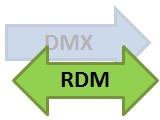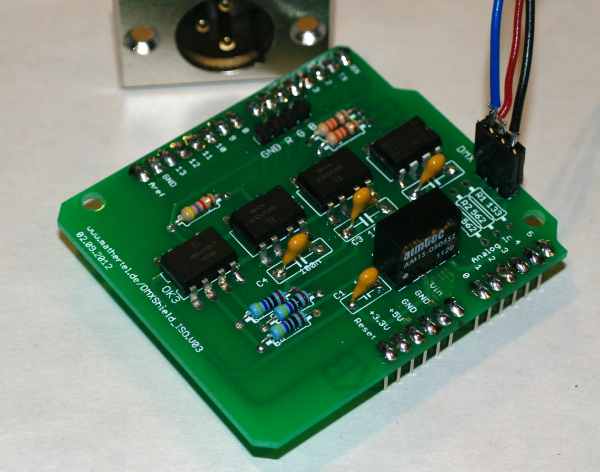The last version of the shield with it’s features and internals can be found on http://www.mathertel.de/Arduino/DMXShield.aspx .
This new version of the shield has no functional additions, so it works exactly like the shield in version v03 that is in use in multiple installations. But there are some improvements by adjusting some values and make its use more flexible when using it on top of an Arduino MEGA and other shields.
The most obvious features of the new (V04) version of the DMX Shield are the better placements of some of the components and the addition of all the shield connectors from the current Arduino boards.
Fixes to resistor values
The values from the optocoupler OK3 transferring the receiving signal in version v03 are adapted to the other optocouplers.
The 3 resistors (R4, R5, R6) are used to limit the current for the internal LEDs of the optocouplers. They had 300 or 470 Ohm in the first layout. These values are now made equal to 470 Ohm which is sufficient.
The 3 resistors (R7, R8, R9) are used to pull the output value of the optocoupler to HIGH also had different values of 470 or 4,7k Ohm. These values are now also made equal to 4,7k Ohm which is also sufficient. The downside of it is that the resistors are hard to distinguish.
I use both adjustments in some installations and they run fine.
The error in the naming of R1 and R2 is fixed.
Here is a picture of the shield with some assembly hints:

Flexibility for Arduino MEGA
The signals RX, TX and D2 are now brought to the pins d0, d1, d2 via a solder jumper. These 3 jumpers should be closed by dropping a small part of solder upon them for normal operation with Arduino Uno or Leonardo Boards.
If you like to use other serial ports or signals like on the Arduino MEGA you can leave these jumpers open and connect the signals the way you like.
The ICSP header of the Arduino board can now be brought to the next shield above the DMX shield by soldering a stackable header.
All the 4 holes from the Arduino Uno Board are now also available to the shield for building permanent robust stacks.
ICSP header and more pins.
All of these extensions are not needed by the DMX shield but it is a good practice to have connection pads and holes at these positions so the signals can be passed through.
Some Arduino shields are using the ICSP header to access the SPI signals from the ATmega chip. The Ethernet shield is a good example for that and there are good reasons to do so.
Not the new version of the DMX shield has 6 contacts right where a ICSP connector can be soldered to pass through the signals to a shield above.
Also 2 of the Arduino header pins have been expanded since some versions. The POWER connector is now 8 pins long and includes IOREF signal. The upper digital connector is now 10 pins long and include the SDA and SCL signals.
Because the DMX shield does not need these signals you can leave these pins without soldering a header or use the (old) shorter headers if you like.
Partlist DMX Shield
Here are the parts you need for a full assembly. It’s also a good order of soldering them.
| Part name | Value | Description |
| Starting with the low parts... |
| R4, R5, R6 | 470 Ω | Bands: (yellow, purple, black, brown, brown*) or (yellow, purple, brown, silver*) |
| R7, R8, R9 | 4,7 kΩ | Bands: (yellow, purple, black, black, brown*) or (yellow, purple, red, silver*) |
The resistors R1 - R3 should be adjusted for the role of the DMX board in your DMX setup.
This configuration is for a DMX / RDM Controller. Don't use them when implementing a DMX or RDM Slave. |
| R1, R3 | 562 Ω | Bands: (green, blue, red, black, brown*) |
| R2 | 133 Ω | Bands: (brown, orange, orange, black, brown*) |
| Now the capacitators... |
| C1,C2,C3,C4 | 100n | Capacitors stabilizing the power. Label: 104 |
| The dc-dc converter... |
| DC1 | NME 0505 | A dc-dc-converter. The chip that provides another 5 v source for the DMX signal converter. |
| Now you can check if the secondary 5v power is existing. Put it on top of an Arduino and measure the voltage at the capacitor C4. It should be near by 5V. |
| The optocouplers and the driver chips... |
| IC1 | MAX481CPA | A MAX481CPA or MAX485 CPA from Maxim or another supplier used to convert the differential DMX signal into a logical signal.
The 8 pin chip can be soldered directly or put on a socket. Be sure to place it in the right direction. |
| OK1, OK2, OK3 | 6N137 | The optocouplers.
The 8 pin chip can be soldered directly or put on a socket. Be sure to place it in the right direction. |
| ...and the connectors |
| DMX | | 1X03 pinhead. I cut it from a longer (20 pin) one. |
| RGB | | 1X04 pinhead |
| stackable headers | | You can solder the usual stackable headers or if you use the shield at the uppermost shield on the Arduino you can solder simple pinheads too. |
| ICSP | | There is no need caused by this shield to solder a ICSP. You can solder one if you like to use the shield with another shield above that needs these connections. |
| solder jumpers | | Don’t forget to close the jumpers when using a standard Arduino. |
I will update the article on the web during the next days and will attach some pictures too.
I ordered more than I need for my projects so if you are interested in the PCB – let me know.



 I just published the version 1.0 of the DMX RDM library as an Arduino library with sample code.
I just published the version 1.0 of the DMX RDM library as an Arduino library with sample code.
